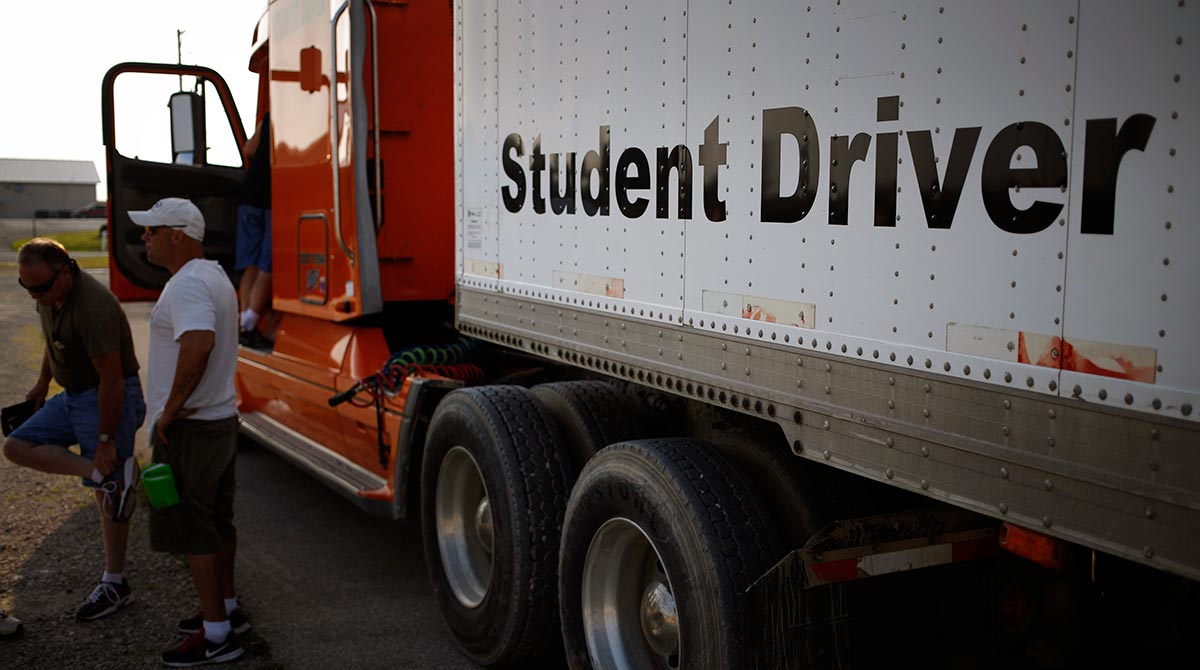New Truck Drivers Thrive as Companies Struggle to Hire

Emily Duck is only 5-foot-4, but she has no trouble shifting the gears, hitting the brakes or climbing into the cab of a big rig that she drives from Edwardsville, Ill., to Kansas City almost every night.
The single mother of two has been hauling freight for three years, benefiting from a national trucker shortage that has companies scrambling to recruit drivers, offering competitive salaries and benefits and, in some cases, paying for their training.
“I went from being broke, making minimum wage and living paycheck-to-paycheck to getting a paycheck that was over $1,000 for one week after taxes,” said Duck, 28, of Belleville.
The job has its drawbacks. Duck works 4 p.m. to 4 a.m. five days a week, taking time away from her two young daughters and limiting her social life. It’s hard to find healthy food along the interstate, she said, and you don’t get much exercise sitting in a truck.

Luke Sharrett/Bloomberg News
But Duck owns a home and a nice vehicle, and she sleeps in her own bed, unlike “over-the-road” drivers who can be gone one, two or three weeks at a time.
“(My daughters) know from listening to other people how cool it is that their mom does this, but they don’t like my work hours,” she said. “They don’t like how much I work.”
Shortage expected to get worse
A study conducted last year by Bob Costello, chief economist for American Trucking Associations, estimated the driver shortage would reach 50,000 by the end of 2017 and 174,000 by 2026.
Costello cited several reasons, including a workforce that is aging and overwhelmingly male (only 6% are female); recruitment challenges related to the trucking lifestyle, which doesn’t appeal to everyone; and new regulations that limit shift lengths, requiring more drivers to haul the same amount of freight.
“It’s kind of the best-kept secret in employment right now,” said Brett Reinert, associate vice president of strategic initiatives at Lewis and Clark Community College who oversees its truck-driving program in Bethalto, Ill.
“As an occupation, it’s old, so there are a lot of retirees,” he said. “At the same time, it’s a growing industry, so you have new positions. There is work available for anyone who has a commercial driver’s license right now, assuming you don’t have a criminal record.”
Depending on the company, starting salaries range from $35,000 to $40,000 a year for route drivers who go home each night and more for regional or cross-country, Reinert said.
RELATED: Truck driver shortage slows operations at world’s largest newsprint maker
RELATED: Analysis - Is regulation driving the driver shortage?
Extra endorsements are needed to transport liquid or hazardous materials, which can create additional opportunities.
“Employers are falling all over themselves to hire students,” said Rene Dulle, Workforce Solutions Group program manager at St. Louis Community College who oversees its truck-driving program on the Forest Park campus.
“We have eight employers who are going to visit the class (this month), and we only have five students,” she said. “It’s great. The students really get to shop around.”
Commercial driver’s license required

Luke Sharrett/Bloomberg News
Truckers must be 21 years old and possess a Class A commercial driver’s license to take tractor-trailers across state lines. The minimum age is 18 for a Class B license to drive heavy trucks with no trailers.
Illinois and Missouri require physical exams and drug testing, Dulle said, and most trucking companies want verifiable work histories and acceptable driving records.
“You can’t drive with certain heart conditions,” Reinert said. “It’s a safety issue. They want to make sure you are in good enough shape to sit behind the wheel and control the vehicle.”
Two community colleges and a few private schools in the St. Louis area have truck-driving programs, which vary on the number of weeks, tuition and pass rates on licensing tests. Some guarantee job placement.
Lewis and Clark and St. Louis Community College got into the field three years ago after joining seven other colleges in eight states along the Mississippi River and successfully applying for a $24 million U.S. Department of Labor grant to offset costs.
RELATED: 'Crisis' in Ohio’s trucking industry spurs flurry of bills
“We knew there was a huge demand for truck drivers before that,” Dulle said. “But between the equipment, the fuel and the maintenance, it was just too expensive to start a program.”
St. Louis Community College has a regular program and a new pilot apprenticeship program. The latter provides free tuition ($5,000) for five weeks of training to selected students who commit to working a minimum of 18 months for one of three partnering freight haulers.
Apprenticeships are funded by a federal grant administered by the St. Louis Agency on Training and Employment and sponsored by St. Louis Regional Freightway, a branch of Bi-State Development that assists the manufacturing, logistics and transportation industry.
“We want to increase the number of truck drivers and continue to have competitive trucking rates and be competitive in the global market,” said Mary Lamie, executive director of St. Louis Regional Freightway. “And we want to position ourselves to take advantage of the anticipated growth in freight volumes over the next three decades.”
‘Double-clutching’ is a challenge

Luke Sharrett/Bloomberg News
Lead instructor for St. Louis Community College classes is Seth Owens, 38, of Belleville, who covered more than a million miles during his 13 years as a trucker.
Today, he teaches students how to drive and back up tractor-trailers under all kinds of circumstances and do thorough pre-trip inspections. One of the most challenging lessons involves “double-clutching,” he said.
“You have to press the clutch to remove it from a given gear, and then you have to press it again to put it in a different gear,” said fellow instructor Jimmy Sherman, 39, of St. Louis. “It’s one-two-one-two, but you’ve got to do it fast.”
Student John Schmidt, 23, of Kirkwood, Missouri, wants to get a commercial driver’s license because he helps with his grandparents’ farm and needs to haul large loads. He also wants to become a semi mechanic.
Student Brandon Coyle, 26, of St. Charles, Missouri, has been working in the restaurant industry for 10 years and hating it for eight years.
“I’m just looking for something to jump-start me in a different direction and help me support myself a little bit better,” he said. “I would like to see more of the country, and this is a great way to do that.”
Government limits time on road

Luke Sharrett/Bloomberg News
In recent years, the Federal Motor Carrier Safety Administration has imposed stricter truck-driving rules to reduce fatigue and improve safety. Work weeks are limited to 70 hours, work days to 14 hours and driving times to 11 hours.
As of December, the use of electronic log-in devices (like time clocks with touch screens in the cab) are mandatory to ensure compliance.
“That’s one of the reasons we have a driver shortage,” Owens said. “Companies can’t cook the books, so it takes more drivers and more trucks to move the same amount of freight.”
Emily Duck graduated from Belleville West in 2007 and worked in stores, restaurants and bars before going to truck-driving school in California and landing a well-paying job in three days.
Since that time, Duck has worked for four companies, hauling everything from soap to sandwiches, almonds to ammunition in tractor-trailers more than 60 feet long.
“The only time it’s really scary is when it’s windy and I have an empty trailer,” she said. “There’s no weight to hold it down.”
Beyond driving, Duck inspects the big rig at the start of each shift, popping the hood of its 13-foot-tall cab and checking oil, belts, hoses, tires and an air system that powers brakes, suspension, even the driver’s seat.
After her overnight shift ends, Duck sleeps a couple of hours before getting her two daughters, Norah, 6, and Aiko, 7, up and off to school. Then she goes back to bed.
“It is an empowering job, especially as a female,” Duck said. “There’s 80,000 pounds in your control, and to be able to operate the truck and work the hours ... It takes a lot out of a person. Not everyone can do it.”
Distributed by Tribune Content Agency, LLC

